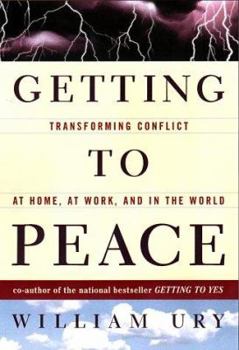Getting to Peace
Select Format
Select Condition 
Book Overview
A millennium manifesto for achieving peace at home, at work, in the community, and in the world from the co-author of the bestselling Getting to YESAlmost twenty years ago, Getting to YES... This description may be from another edition of this product.
Format:Hardcover
Language:English
ISBN:0670887587
ISBN13:9780670887583
Release Date:October 1999
Publisher:Viking Books
Length:192 Pages
Weight:1.20 lbs.
Dimensions:1.3" x 6.3" x 9.3"
Customer Reviews
3 ratings
A hopeful, broad look at the steps toward peace
Published by Thriftbooks.com User , 18 years ago
An anthropologist and expert on negotiation takes a look at violent conflict, both interpersonal and international, and optimistically describes what we can do to prevent, resolve, and contain it. The book is divided into three parts: 1. a description of the importance of the "third side" in a conflict 2. an examination of the history of violent conflict and speculations about its future 3. explanations of ten ways the third side can help to avert violence Ury argues for the importance of what he calls the third side in a dispute, separate from the two conflicting parties but active in resolving conflict. He writes that violence is the ultimate arbiter when there is no other authority to decide an issue between people or groups. When left only to themselves, therefore, disputants tend to spiral into violent conflict to resolve their disagreements. The presence of a third party, however, changes the nature of an argument. Ury contends that a strong third side can go far toward keeping quarrels from becoming battles. One of the book's big ideas is that, although conflict is inevitable (and even helpful), war and violence are not. By taking a historical and anthropological perspective, Ury questions the widely held assumption that war is an inherent part of human nature. He examines the archaeological evidence formerly used to "prove" our violent nature and argues that peace was the norm for the overwhelming majority of the time humans have existed. Ury contends that it was only with the shift from being hunter-gatherers to a settled agricultural and then industrial existence that war became feasible. He then holds out the hope that with the increasingly horizontal relationships and "expanding pie" of the knowledge age, we can return to peaceful coexistence. Finally, the book describes ten different roles that the third side plays to prevent conflict from going out of control, resolve disputes that threaten to escalate, and contain fights that do break out. Ury uses numerous examples to illustrate these roles and show how individuals, organizations, and nations can fill them. The book includes a "road map" outline of the main ideas and an extensive index, both of which help greatly in reviewing its contents. I was impressed by the breadth of Ury's understanding. He brings not only a great deal of academic knowledge but practical experience ranging from resolving union-labor disputes to improving U.S.-Soviet relations during the Cold War to studying how African hunter-gatherer tribes resolve conflict. His optimism about the feasibility of conflict without violence caused me to reevaluate my notions about war and peace. Getting to Peace was published in 1999, before the terrorist attacks on the World Trade Center and America's subsequent invasions of Afghanistan and Iraq. I found it interesting to interpret these events using Ury's framework and to see how the conflict in Iraq might have been handled differently. If the European nations that h
Conflict is not the norm, peace is!
Published by Thriftbooks.com User , 21 years ago
In "Getting to Peace: Transforming Conflict at Home, At Work, and In the World" William Ury, a world famous negotiator, brings his years of experience to the average person. The book takes the view that conflict always has three sides, the two opposing sides and the third side which is that of a peacemaker. Contrary to what most people might think, William Ury takes the position that conflict is not a normal part of human nature, so destructive conflict is not inevitable. He proves his point well by pointing out that while conflict and strife make news, the basic human condition is peaceful conflict resolution punctuated by periods of strife and not strife punctuated by periods of peace. Peace is the norm.The ability to resolve conflict gives us the ability to choose peace in all aspects of our life, at home, at work, at school or anywhere else. By discovering the ten roles of the peacemaker, everyone can learn to mediate destructive conflicts. A highly recommended read.
A lucidly written must-read on how to contain conflict
Published by Thriftbooks.com User , 24 years ago
A powerful treatise on ways that human beings can live together peacefully in the new millennium. The first part of the book invites the reader to re-imagine conflict as three-sided, with those on the Third Side in the role of peacemaker. The second part revisits mankind's past and offers powerful evidence to suggest that destructive conflict may not be part of human nature. The third part invites the reader to become a Third Sider, and offers practical suggestions on how to prevent, resolve, and contain conflict. Ury brings to his work the perspectives of a meticulous anthropologist, brilliant mediator, and compassionate humanitarian. In Getting to Peace the result is a lucidly written book that I highly recommend as a thought-provoking, practical, and stimulating read.





